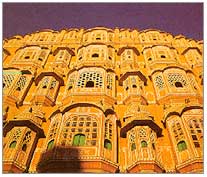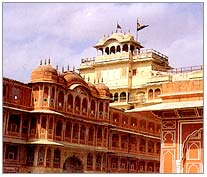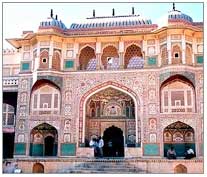RAJASTHAN TOURISM Tour Highlights Jaipur Tourism
Hawa Mahal, Jaipur
 Poet king Sawai Pratap Singh built this palace of winds. This is the most
easily recalled landmarks of Jaipur and is also its icon. Located in the
city Palace it is best viewed from the outside for the palace is really
a facade.
Poet king Sawai Pratap Singh built this palace of winds. This is the most
easily recalled landmarks of Jaipur and is also its icon. Located in the
city Palace it is best viewed from the outside for the palace is really
a facade. This five-storey building overlooking the busy bazaar street is a stunning example of Rajput architecture and artistry with its pink delicately honeycombed 953 sandstone windows known as 'jharokhas'.
It was originally built for the ladies of the royal household to watch everyday life and processions in the city from their veiled comfort.
Most people come here to get a view of the facade but they can also climb to the top for a wonderful view from the latticed windows. There is also a small archaeological museum there. Entry to foreigners/citizen is Rs 30/10.
The Hawa Mahal, or the "Palace of Wind" built by Maharaja Sawai Pratap Singh in 1799 A.D. is characterised by elaborate and fanciful architecture.
The broad pyramidical facade comprises five storeys of semi octagonal overhanging windows with perforated screens, domes and spires.
Jantar Mantar, Jaipur
Across the road from the palaces is the famous JANTAR MANTAR one of the five observatories in India . Built by Sawai Jai Singh, this is one of the largest and the best preserved. A passionate hobby of the king in the field of Astronomy, numerology, insighted him to execute this observatory and with the help of skilled labourers, they managed to create a collection of complex astronomical instruments chiselled out of stone and most of which continues to provide accurate information to this day.
The most striking instrument is the Brihat Samrat yantra Sundial, an imposing yellow edifice to the far right of the observatory complex which has a 27m high gnomon arm set at an angle of 27degree.
The shadow this casts moves up to 4m in an hour, and aids in the calculation of local and meridian pass time and various attributes of the heavenly bodies, including declination the angular distance of a heavenly body from the celestial equator and altitude. This highlight of the observatory has made it a centre of attraction for the tourist visiting Jaipur.
Jantar Mantar is the most famous and elaborate observatory of its time. It was constructed in the year 1724 A.D. by Sawai Jai Singh II, even before the city of Jaipur was built, and has been described as the most surrealistic and logical landscape instone.
It was built to measure the local time, the sun's declination, altitude, the declination of stars, planets and to determine eclipses.
City Palace, Jaipur
Located in the heart of the walled city, The City Palace Complex gives you an idea about the farsightedness of the founder of Jaipur Sawai Jai Singh. He left behind a legacy of some of the most imposing and magnificent architecture, art and craft structure in the city. Sawai Jai Singh built its many buildings but some of some of the structures were also built by later rulers and some of them are even dated in the in the twentieth century too. The palace is a blend of Mughal and Rajasthani architecture and the royal family still lives in a part of the palace.

On entering the complex and before the palace proper lies the Mubarak Mahal, the palace of welcome or reception. Sawai Madho Singh built the palace in the nineteenth century. It was used as a reception centre for the visiting personage. The building now forms the Maharaja Sawai Man Singh II Museum and on display here are a wide array of royal costumes, some very exquisite and precious Pashmina (Kashmiri) Shawls, Benaras silk saris, Sanganeri prints and folk embroidery. An unusual display is that of voluminous clothes worn by Maharaja Sawai Madho Singh I (ruled 1750-68).
The Maharani's Palace, the palace of the Queen paradoxically puts a display of the Rajput weaponry. The inestimable collections of weapons date back to even 15th century and are in a remarkable state of preservation. Remarkable amongst them is scissor-action dagger. This deadly weapon when thrust in bodies the handles were release to spread the blades. The dagger was then withdrawn tearing limb from limb of the body of the hapless victim into certain fatality. Other exhibits include protective chain armours, pistols, jewelled and ivory handled swords, a belt sword, small and assorted cannons, guns, poison tipped blades and gun powder pouches. The frescos on the ceiling are amazing and well preserved.
The art gallery is located in the Diwan-I-Aam, which literally mean the Hall of public audience. The exhibits here included some very precious and ancient handwritten original manuscripts of Hindu scriptures. Particularly intriguing in miniature copies of Bhagwat Gita made in this manner so that it can be concealed out of sight of Emperor Aurangzeb's onslaught on Hindu scriptures. Some very delicate miniature paintings in Rajasthani, Mughal and Persian schools on various themes including the Ramayana are very engrossing displays. Visitors must also take a good at preserved painted ceilings. Also on display are elephant saddles called "haudha".
Between the armoury museum and the art gallery is the Diwan-I-Khas meaning hall of private or selective audience. This is a marble paved pavilion and puts on display the world largest sterling silver object two gigantic silver vessels. These vessels were made for Maharaja Sawai Madho Singh II, who took in along with him filled with water from River Ganga for drinking. As a devout Hindu the Maharaja did not wish to risk polluted English waters. The ceiling also has large chandeliers, which are mostly protected by dust covers and opened only of festive occasions. The Guinness Book of Records accounts it has the biggest silver objects in the world.
The Chandra Mahal Palace is still occupied by the royal family but visitors can visit the ground floor where some exhibits are on display. However the visit here is worthwhile for the exquisite Peacock in the courtyard outside. The present day royal family that takes charge of the museum has done exceptionally well in preserving this legacy in fine state maintenance and presentation. A visits to the palace is enlightening one for its extraordinary occurrence.
Amber Fort, Jaipur
Amber (pronounced Amer) is situated about 11 kilometres from Jaipur and was the ancient citadel of the ruling Kachhawa clan of Amber, before the capital was shifted in the plains to present day Jaipur. The Amber Fort set in picturesque and rugged hills is a fascinating blend of Hindu and Mughal architecture. Constructed by Raja Man Singh I in 1952 and completed by Sawai Jai Singh I the fort is made in red sand stone and white marble.
The rugged forbidding exterior belies an inner paradise with a beautiful fusion of art and architecture. Amber is the classic and romantic fort- palace with a magnificent aura. The interior wall of the palace depicts expressive painting scenes with carvings, precious stones and mirror settings. In the foreground is the Maota Lake providing a breathtaking look. Built mainly for the warring enemies as a safe place, the heavily structured walls could defend the residents within the ramparts of the fort.

All the means of survival & luxuries for the royal families and the people who were concerned with the functioning of this small kingdom of the Kachhawas were well provided. The Rajputs who had apparently won a small structure passed on by Meena tribes, later on renovated it into the grand Amber Fort. Holding a history so old as 7 centuries, this place vibrates with its legendry past, in the archaeological history. Although many of the early structures have been literally ruined but at the same time, those dating from the 16th century on are remarkably preserved by sincere efforts.
The fort has 4 sections; each with the premises and one has to climb up through the imposing stairway or else the broad aisle, where one can ride on the elephant back for royal feel. The main gate Surajpol that leads to the Jaleb chowk, which is the main courtyard from where one can walk up the stairway, that leads to the palace. Jaleb Chowk was also the area where returning armies were welcome and they would display their war earnings to the population at large.
Before you enter the palace just towards the right is a sleep aisle and a narrow staircase reaching up to Kali Temple also called Shila Devi Temple famous for its mysterious history and the huge silver lions. It is a gorgeous temple featuring silver doors with raised relief. According to a legend, Maharaja Man Singh I had worshiped the Goddess for a victory over the rulers of Bengal.
The Goddess appeared in the Maharaja's dream and ordered him to recover her statue lying under sea near Jessore (now in Bangladesh) and install it in a befitting Temple. True enough, after subjugating the enemies the Maharaja recovered the statute from the bed of the sea. The temple is called after Shila Devi, "shila" meaning stone slab. Like all temples this too has an image of Ganesha on the doorway, but carved from a single piece of coral.
Getting back from the temple the main stairways lead to the second courtyard of the fort. Here situated is the imposing Diwan-I-Aam, the hall of public audiences where the Maharaja received the populace and their petitions. This is a pavilion of double row of columns each capped by an elephant shape. There is a lattice gallery also.
Behind the exquisite and fabulous Ganesh Pol, "pol" meaning gate are located in the residential apartments of the Maharaja. The Jai Mandir, the Hall of Victory is famous for its inlaid panel and dazzling mirror ceiling. Much of it had deteriorated with neglect and is under restoration.
On the other side is Sukh Niwas, the residence of pleasure or pleasurable residence. The palace has an ivory inlaid sandalwood door. A channeled laid for flow of water is an inventive system of cooling. The water flowing from the channel wasn't wasted as it was allowed to flow in the garden. From there you can also take pleasure in viewing of the fort rampart and its reflection in the Moata Lake.
The Zenana or the palace of the women are in the forth courtyard. The rooms are though connected through a common corridor are cleverly designed to give each room privacy so that the Maharaja can have nocturnal visits to his various Maharanis without notice of the other.
Jaipur Tourism - Best Price with Free Itinerary Suggestion









